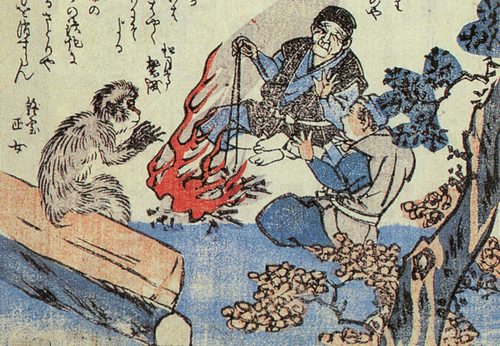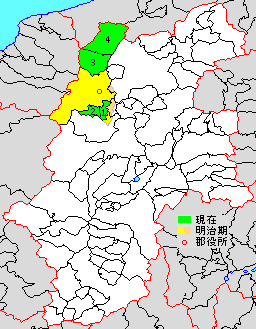|
Yamabiko (folklore)
is a mountain god, spirit, and yōkai in Japanese folklore; the term "yamabiko" also refers to the echo that occurs in mountains, after which the yōkai is named. Literally translated, the term means "mountain boy". It is the yōkai responsible for the natural phenomenon in mountains or canyons. Living deep in the mountains, direct encounters with the yamabiko are rare. Often they are heard, but never seen. The small and elusive yokai wasn't officially classified until the Edo period in Japan. Instead the bizarre noises coming from the mountain were attributed to a natural phenomenon, like birds, and not given any spiritual significance. It is usually depicted with gray fur, peach-colored belly, floppy ears, large grin, and arms outstretched as though it is caught mid-shrug. Mythology The yamabiko is a small creature that resembles a cross between a dog and a monkey. The term "yamabiko" is also used to describe the phenomenon of a delayed echo in mountains and valleys, and is ... [...More Info...] [...Related Items...] OR: [Wikipedia] [Google] [Baidu] |
Kakuen
() is a legendary animal in the legends of China. They are also called (in Japanese or ), , , (in Japanese ), and (in Japanese ). They are similar to monkeys, and thus possess a characteristic of carrying away human females and violating them. Summary According to the medical herb book , they are bigger than monkeys, and according to the , a ) that lives for 800 years becomes a , and if they live for 500 more years, then they become a jué, which can live 1000 more years. In the ''Bencao Gangmu'', it is written as and . A "jué" is a monkey that has grown old, and has a dark blue color. It walks like a human, and they often kidnap humans or objects. There are only males and no females, and therefore they would abduct human females who then give birth to children. According to ''Soushen Ji, In Search of the Supernatural'' ( and a book titled , under the names , , and , there is as follows. They live in the mountains in southwest Shu Han, Shu, and resemble monkeys, and with ... [...More Info...] [...Related Items...] OR: [Wikipedia] [Google] [Baidu] |
Satori (folklore)
in Japanese folklore are mind-reading monkey-like monsters ("yōkai") said to dwell within the mountains of Hida Province, Hida and Mino Province, Mino (presently Gifu Prefecture). Mythology People are said to meet them while walking along mountain paths or resting in the mountains. Upon reading a person's mind, the satori would say the person's thoughts aloud faster than a human could. There is also a theory that they are the child incarnations of Yama-no-Kami, mountain gods who have come to ruin and turned into a yōkai form. They would appear before people at mountain huts, and are even said to try to eat and kill if they have a chance, but if something unexpectedly strikes the satori, they become stricken with fear and run away. There is also a theory that they do not present any danger to people and would not dare to harm those who work on the mountain, allowing people to coexist with satori. A satori is depicted in Toriyama Sekien's ''Konjaku Gazu Zoku Hyakki'', but since ... [...More Info...] [...Related Items...] OR: [Wikipedia] [Google] [Baidu] |
Penghou
The Penghou (, pronounced ʰə̌ŋ.xǒʊ literally: "drumbeat marquis") is a tree spirit from Chinese mythology and folklore. Two Chinese classics record similar versions of the Penghou myth. The (c. 3rd century) ''Baize tu'' (白澤圖, "Diagrams of the White Marsh"), named after the Baize "White Marsh" spirit recorded in the ''Baopuzi'', is no longer fully extant, but is identified with a Dunhuang manuscript (P2682). It describes the Penghou: A creature that has evolved from the essence of wood is called Penghou. It looks like a black dog with no tail and its meat can be prepared as food. The essence of a 1,000-year-old tree may evolve into a spirit called Jiafei. It looks like a pig. Its meat tastes like dog meat. (tr. Luo 2003: 4132) The (c. 4th century) ''Soushenji'' (搜神記, "In Search of the Supernatural") has a story about "The Penghou in the Camphor Tree": During the Wu Kingdom (Three Kingdoms Period, 220–280) Jing Shu felled a big camphor tree. Then the wood bl ... [...More Info...] [...Related Items...] OR: [Wikipedia] [Google] [Baidu] |
List Of Legendary Creatures From Japan
The following is a list of Akuma (demons), Yūrei (ghosts), Yōkai (spirits), Kami and other legendary creatures that are notable in Japanese folklore and mythology. A B C D E F G H I J K A Kesaran Pasaran ... [...More Info...] [...Related Items...] OR: [Wikipedia] [Google] [Baidu] |
Nagano Prefecture
is a Landlocked country, landlocked Prefectures of Japan, prefecture of Japan located in the Chūbu region of Honshu. Nagano Prefecture has a population of 2,007,682 () and has a geographic area of . Nagano Prefecture borders Niigata Prefecture to the north, Gunma Prefecture to the northeast, Saitama Prefecture to the east, Yamanashi Prefecture to the southeast, Shizuoka Prefecture and Aichi Prefecture to the south, and Gifu Prefecture and Toyama Prefecture to the west. Nagano (city), Nagano is the capital and largest city of Nagano Prefecture, with other major cities including Matsumoto, Nagano, Matsumoto, Ueda, Nagano, Ueda, and Iida, Nagano, Iida. Nagano Prefecture has impressive highland areas of the Japanese Alps, including most of the Hida Mountains, Kiso Mountains, and Akaishi Mountains which extend into the neighbouring prefectures. The area's mountain ranges, natural scenery, and history has gained Nagano Prefecture international recognition as a winter sports tourist de ... [...More Info...] [...Related Items...] OR: [Wikipedia] [Google] [Baidu] |
Kitaazumi District, Nagano
is a district located in Nagano Prefecture, Japan. As of 2023, the district has an estimated population of 29,918 with a density of 54.9 persons per km2. The total area is 544.5 km2. Municipalities The district consists of one town and three villages: * Hakuba is a village located in Nagano Prefecture, Japan. As of April 1, 2019, the village had an estimated population of 9,007 in 4267 households, and a population density of 48 persons per km2. The total area of the village is . Hakuba is located i ... * Ikeda * Matsukawa * Otari ;Notes: History District Timeline * 1878 - Founded after Azumi District was split into Minamiazumi and Kitaazumi Districts. Districts in Nagano Prefecture {{Nagano-geo-stub ... [...More Info...] [...Related Items...] OR: [Wikipedia] [Google] [Baidu] |
Gazu Hyakki Yagyō
is the first book of Japanese artist Toriyama Sekien's famous ''Gazu Hyakki Yagyō'' e-hon tetralogy, published in 1776. A version of the tetralogy translated and annotated in English was published in 2016. Although the title translates to "The Illustrated Night Parade of a Hundred Demons", it is based on an idiom, ''hyakki yagyō,'' that is akin to wikt:pandemonium, pandemonium in English and implies an uncountable horde. The book is followed by ''Konjaku Gazu Zoku Hyakki'', ''Konjaku Hyakki Shūi'', and ''Gazu Hyakki Tsurezure Bukuro''. The book is a supernatural bestiary, a collection of ghosts, spirits, spooks and monsters from Japanese literature, literature, Japanese folklore, folklore, and other Japanese art, artwork. The art of ''Gazu Hyakki Yagyō'' heavily references a 1737 scroll-painting called the ''Hyakkai Zukan'' by artist Sawaki Sūshi; Sekien's innovation was preparing the illustrations as woodblock prints that could be mass-produced in a bound book format. Intend ... [...More Info...] [...Related Items...] OR: [Wikipedia] [Google] [Baidu] |
Hyakkai Zukan
is a picture scroll by Edo period Japanese artist Sawaki Suushi. Completed in 1737, this scroll is a supernatural bestiary, a collections of ghosts, spirits and monsters (Yōkai), which Suushi based on Japanese literature, literature, Japanese folklore, folklore, other Japanese art, artwork. These images had a profound influence on subsequent ''yōkai'' imagery in Japan for generations. Scroll gallery Image:Suushi_Mikoshi-nyudo.jpg, Image:Suushi_Shokera.jpg, Image:Suushi_Hyosube.jpg, Image:Suushi_Nure-onna.jpg, Image:Suushi_Kappa.jpg, Image:Suushi_Gagoze.jpg, Image:Suushi_Nurarihyon.jpg, Image:Suushi_Kasha.jpg, Image:Suushi_Ubume.jpg, Image:Suushi_Nuppeppo.jpg, Image:Suushi_Waira.jpg, Image:Suushi_Otoroshi.jpg, Image:Suushi_Yama-biko.jpg, Image:Suushi_Nuribotoke.jpg, Image:Suushi_Ouni.jpg, Image:Suushi_Yume-no-seirei.jpg, Image:Suushi_Yama-uba.jpg, Image:Suushi_Inugami.jpg, Image:Suushi_Nukekubi.jpg, Image:Suushi_Yama-warau.jpg, Image:Suushi_Uwan.jpg, Image ... [...More Info...] [...Related Items...] OR: [Wikipedia] [Google] [Baidu] |
Penghou
The Penghou (, pronounced ʰə̌ŋ.xǒʊ literally: "drumbeat marquis") is a tree spirit from Chinese mythology and folklore. Two Chinese classics record similar versions of the Penghou myth. The (c. 3rd century) ''Baize tu'' (白澤圖, "Diagrams of the White Marsh"), named after the Baize "White Marsh" spirit recorded in the ''Baopuzi'', is no longer fully extant, but is identified with a Dunhuang manuscript (P2682). It describes the Penghou: A creature that has evolved from the essence of wood is called Penghou. It looks like a black dog with no tail and its meat can be prepared as food. The essence of a 1,000-year-old tree may evolve into a spirit called Jiafei. It looks like a pig. Its meat tastes like dog meat. (tr. Luo 2003: 4132) The (c. 4th century) ''Soushenji'' (搜神記, "In Search of the Supernatural") has a story about "The Penghou in the Camphor Tree": During the Wu Kingdom (Three Kingdoms Period, 220–280) Jing Shu felled a big camphor tree. Then the wood bl ... [...More Info...] [...Related Items...] OR: [Wikipedia] [Google] [Baidu] |
Wakan Sansai Zue
The is an illustrated Japanese ''leishu'' encyclopedia published in 1712 in the Edo period. It consists of 105 volumes in 81 books. Its compiler was Terashima or Terajima Ryōan, Terajima (), a doctor from Osaka. It describes and illustrates various activities of daily life, such as carpentry and fishing, as well as plants and animals, and constellations. It depicts the people of "different/strange lands" (''ikoku'') and "outer barbarian peoples". Sources used As seen from the title of the book (Wa (Japan), wa , which means Japan, and Han dynasty, kan , which means China), Terajima's idea was based on a Chinese encyclopedia, specifically the Ming dynasty, Ming work ''Sancai Tuhui'' ("Pictorial..." or "Illustrated Compendium of the Three Powers") by Wang Qi (encyclopedist), Wang Qi (1607), known in Japan as the . Reproductions of the ''Wakan Sansai Zue'' are still in print in Japan. References External links Scansof the pages are available in thof the National Diet Libra ... [...More Info...] [...Related Items...] OR: [Wikipedia] [Google] [Baidu] |
Sukumo, Kōchi
270px, Aerial view of Sukumo Bay is a city located in Kōchi Prefecture, Japan. , the city had an estimated population of 19,292 in 9,966 households, and a population density of 67 persons per km². The total area of the city is . Geography Sukumo is located in far western Kochi Prefecture on the island of Shikoku. The islands of Okinoshima and Urugushima are within Sukomo city limits despite being geographically closer to neighboring Ōtsuki; these are the only inhabited islands located fully within the prefecture. Parts of the city are within the borders of the Ashizuri-Uwakai National Park. Neighbouring municipalities Ehime Prefecture * Ainan * Uwjima Kōchi Prefecture * Mihara * Ōtsuki * Shimanto City * Tosashimizu Climate Sukumo has a humid subtropical climate (Köppen climate classification ''Cfa'') with hot, humid summers and cool winters. There is significant precipitation throughout the year, especially during June and July. The average annual temperature in S ... [...More Info...] [...Related Items...] OR: [Wikipedia] [Google] [Baidu] |



